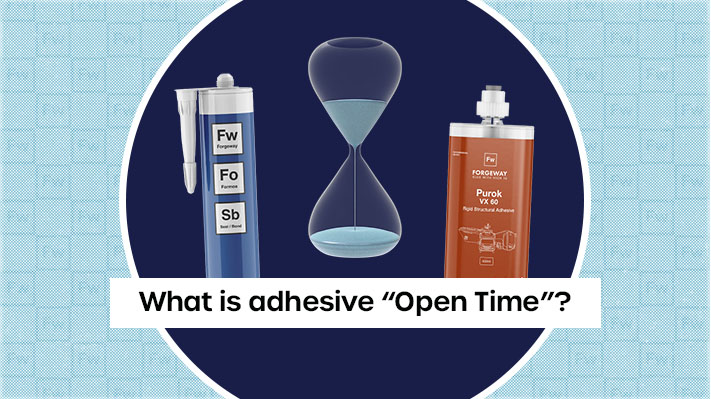
When it comes to choosing an adhesive, there are plenty of different phrases that adhesive manufacturers will tell you about the adhesive. One of those phrases is ‘open time’. Now you’re wondering what it actually means and why it even matters in an adhesive.
We often try and explain this to our customers here at Forgeway. We have been manufacturing industrial adhesives for over 25 years. We have found that open time can be one of the most important characteristics of an adhesive.
In this article, we will describe the definition of adhesive open time. Then we will discuss why it can be such an important part of an adhesive. By the end of the article, you will know whether the open time is going to be an important characteristic of your adhesive option.
What is adhesive open time?
Adhesive open time is the amount of time you have to bond the substrates (materials) together before the adhesive starts to form a skin that you can’t bond to. The longer you leave the adhesive after the stated open time, the less likely it is to form a strong bond. The risk of adhesive failure increases substantially.
Effectively, open time dictates how much time you have to put the structures in place before the adhesive starts curing. You should always remember that you can manipulate the stated open time.
Temperature, humidity, and bondline thickness can have an impact on the open time of an adhesive. For example, an adhesive may have an open time of 20 minutes at 23℃. The more you increase that temperature, the open time will decrease. And you could reverse that too. The more you decrease that temperature, the open time will increase.

Why does adhesive open time matter?
The open time of an adhesive is important. Too short, and you won’t be able to form a secure bond. Too long, and you will be waiting a long time for the adhesive to start curing before it reaches handling strength.
Let’s put this into a practical example to help you understand this. You are bonding side panels onto a bus. The adhesive you are using has an open time of 15 minutes. However, it takes you 20 minutes to apply the adhesive to all the areas you need.

This means that the adhesive you applied at the beginning will have already passed the stated open time. You will struggle to form a strong bond with this adhesive as it will have already started to cure.
In this particular scenario, there are a few solutions to resolve this. You can apply the adhesive in stages to ensure the adhesive doesn’t go past the open time.
Or, if you are using a moisture-curing adhesive, you can cut the nozzle so the adhesive forms a triangular bead. This will mean the outside forms a skin but there is still active adhesive on the inside of the triangle that you can bond to when pushing the substrate in place.
The problem arises when you want a fast-curing adhesive. When an adhesive cures quickly, the open time will usually be shorter because it begins the curing process sooner.
However, there are some adhesives (like MMAs) that have a long open time (more than 25 minutes) but also have a fast cure time (less than an hour. It all comes down to what you need from the adhesive.
What else should you consider apart from adhesive open time?
So now you know the definition of adhesive open time, you can decide what open time you want from your adhesive. This article will have helped you decide. But what else do you need to consider when purchasing an adhesive?
Here at Forgeway, we manufacture industrial adhesives. We help companies choose the right adhesive for their application. We know that open time is one characteristic you need to get right from your adhesive.
But what about the others? What else might you need from your adhesive? We wrote an article that goes over everything you need to consider before choosing an adhesive.
It will guide you through the different characteristics of an adhesive and help you decide which adhesive is right for you. Or, you’re finding that your challenge is unique. The help of an adhesive expert will give you the answer you need.
A member of our team would be more than happy to help you on your mission to find the right adhesive for your application. Reach out to find the exact adhesive match for your application.
Thomas is the Content Manager here at Forgeway. Thomas' job is to translate the technical jargon from the ivory tower of academia into easy-to-read content that everyone can understand. Forgeway's mission is to answer every question our customers and prospective clients ask, or are apprehensive to ask.
Topics:



